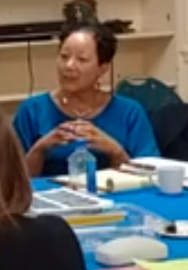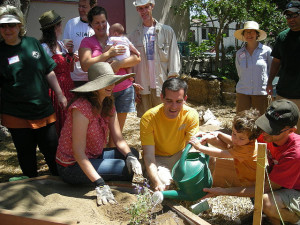
… but what’s the role for BIDs? I mean, so many of our BID officers are front line on the street. I met with Central City East BID, this BID, there was another BID, um, I forgot, but, you know, there was another BID that we’ve just been talking to, and the spike in violence, spike in substance abuse, the spike in, um, families, so it’s people with children that are out on the street in these encampments and often are abandoned, sometimes if their parents are active substance abusers, just the spike in the number of people, the spike in, the sense of permanency, I would say, with encampments, when before they’ve been, you know, none of this is [unintelligible], but someone may have been in a sleeping bag at the bus stop, but now, those coming in [unintelligible], they’re out in San Pedro, there was like a block-long encampment, that was pretty sturdy, you wouldn’t just be able to go in and take it down, you know, at some point, there was carpentry skills keeping it up, so it’s, it’s, how do we, how do we, adjust this, and what are, what do you guys see, and what’s, how can we empower BIDs so that, that information that they’re seeing and that experience that they’re having is fed back into us as policy-makers and we can together come [unintelligible] a solution.

And Garcetti thinks they need MORE power to deal with the homeless? Part of his state of emergency is to give the BIDs MORE POWER? This is what Garcetti’s “policy-makers” are thinking? It can’t be true. At this point, the principle of charity actually forces us to assume they’re lying, because if they’re telling the truth they’d have to be more stupid than seems humanly possible.

…and the spike in violence, spike in substance abuse, the spike in, um, families, so it’s people with children that are out on the street in these encampments and often are abandoned, sometimes if their parents are active substance abusers, just the spike in the number of people, the spike in, the sense of permanency, I would say, with encampments, when before they’ve been, you know, none of this is [unintelligible], but someone may have been in a sleeping bag at the bus stop, but now, those coming in [unintelligible], they’re out in San Pedro, there was like a block-long encampment, that was pretty sturdy, you wouldn’t just be able to go in and take it down, you know, at some point, there was carpentry skills keeping it up…
Now, we gotta get all Freud here for a minute. We’ve seen that Alisa’s not real, you know, big on coherence and so forth, but why does she interject all these things in the middle of her little speech about empowering the BIDs and after just saying that she’s met with the CCEA? We’ve got to figure it’s because this is the kind of stuff that CCEA head-honcho-etta and aggressively brittle lunatic Raquel K. Beard filled Alisa’s head up with at their meeting. We mean, look at Raquel’s facebook thing here where she got a homeless kid taken away from her parents by CPS (here is a PDF of the whole thing if, like us, you don’t want to have anything to do with facebook. Read the comments if you want to remember WHY you don’t want anything to do with facebook).1 These are Raquel’s obsessions coming out of Alisa’s mouth, which is just what we want in our policy-makers, innit?
Now, finally, let’s finish up with what Alisa, and therefore, we assume, Eric Garcetti, sees as an example of permanent housing:“…permanent housing could be [unintelligible], paying someone’s back rent who’s living with their parents so that their parents will allow them to move back to live with them.” Now, we’re not “policy-makers,” but we are parents, and we can tell you right now that if homeless people aren’t already living with their parents, there are more serious reasons than that their rent isn’t paid. We’re even willing to believe that if you ask either the homeless people or their parents why the homeless kid is not living with the parents, they may all agree that it’s because the rent’s not paid. But that won’t actually be true. There must be something more serious going on. Either the kid is too mentally ill or drug-addicted to live in the parents’ house any more, but the parents can’t bring themselves to say it, even possibly to themselves, so they blame it on the rent. Or the parents are too fucked up (we don’t mean they’re evil, just that they can’t keep their own lives together sufficiently) to take care of the kid, which includes the possibility that they actually would kick the kid out simply due to rent, or something. Maybe some combination of these things, or maybe something we haven’t thought of or experienced. Really, if the homeless person is not living with the parent then then rent is not the reason.
That’s a minor thing in the real world, but when self-proclaimed “policy-makers” like Alisa Orduna representing Los Angeles Mayor Eric Garcetti want to include “paying someone’s back rent…so that their parents will allow them to move back to live with them” as a freaking example of a kind of permanent housing in their freaking state-of-emergency homeless policy, something’s gone entirely off the rails. We found out yesterday that the money’s made up, that the money that does exist is going to buy iPads for the BID Patrol, and now we discover that the big permanent housing plan is to pay people’s parents to let them back in the house? Where are the grownups in the room here? Where are they?

Transcription:
Alisa Orduna:…and so it’s redesigning the design of shelters so that there’s a pathway out, it’s not just a door in, but a door back out the front door so the door’s like, spinning, but there’s an actual door out to some kind of, and I’m just gonna use permanent housing, often times we think of like a building across the street, I’m looking over there, like, we think of a physical development. But permanent housing could be [unintelligible], paying someone’s back rent who’s living with their parents so that their parents will allow them to move back to live with them. It could be, again, short-term subsidies cause someone is waiting for that job offer or maybe they’re out on medical disability but they’ll be back to work in a few months. It could be finding the right room-mate in a shared housing situation, or it could be finding them section 8, or, if it’s more severe, someone with severe mental illness, you know, there’s different products for, but the idea is that we’ve gotta get creative, how do we create affordable housing for people who live in Los Angeles, including our homeless population. And now it’s time for community to be very creative and say, you know what? We don’t want the kind of shelter that where we’re gonna have where people are lining around the block at seven o’clock at night. We don’t want that. We want a kind of program where we know that bed is gonna turn over at least three times in one year because people are actually moving into housing. And we want, you know, what size? What are the programs? What are the local community supports that could help people link up to employment, to medical services, to becoming better advocates in the public schools if they have children. So you know, all of that, that, I’m really sincere when the mayor’s very open to new ideas on how to do this. And it’s a different kind of empowerment, I think that, communities often are used to. And one point too, and I still wanna listen as well, [unintelligible] technical policies, but what’s the role for BIDs? I mean, so many of our BID officers are front line on the street. I met with Central City East BID, this BID, there was another BID, um, I forgot, but, you know, there was another BID that we’ve just been talking to, and the spike in violence, spike in substance abuse, the spike in, um, families, so it’s people with children that are out on the street in these encampments and often are abandoned, sometimes if their parents are active substance abusers, just the spike in the number of people, the spike in, the sense of permanency, I would say, with encampments, when before they’ve been, you know, none of this is [unintelligible], but someone may have been in a sleeping bag at the bus stop, but now, those coming in [unintelligible], they’re out in San Pedro, there was like a block-long encampment, that was pretty sturdy, you wouldn’t just be able to go in and take it down, you know, at some point, there was carpentry skills keeping it up, so it’s, it’s, how do we, how do we, adjust this, and what are, what do you guys see, and what’s, how can we empower BIDs so that, that information that they’re seeing and that experience that they’re having is fed back into us as policy-makers and we can together come [unintelligible] a solution.
- H/T Kim Cooper of Esotouric.
Image of Alisa Orduna blethering on is ©2015 MichaelKohlhaas.org. Image of Eric Garcetti is by Eric Garcetti, who has kindly made it available via Flickr, where it is proclaimed to have been released under the CC BY-SA 2.0. Image of CCEA office is ©2015 MichaelKohlhaas.org, taken on a recent fact-finding mission downtown. Make-believe ballroom picture is by AK Rockefeller, who has made it available via Flickr and released it under the CC BY-SA 2.0.
